Dominique Chen: Fermentation Meets Digital Culture
Jul 25,2019
Dominique Chen: Fermentation Meets Digital Culture
Jul 25,2019
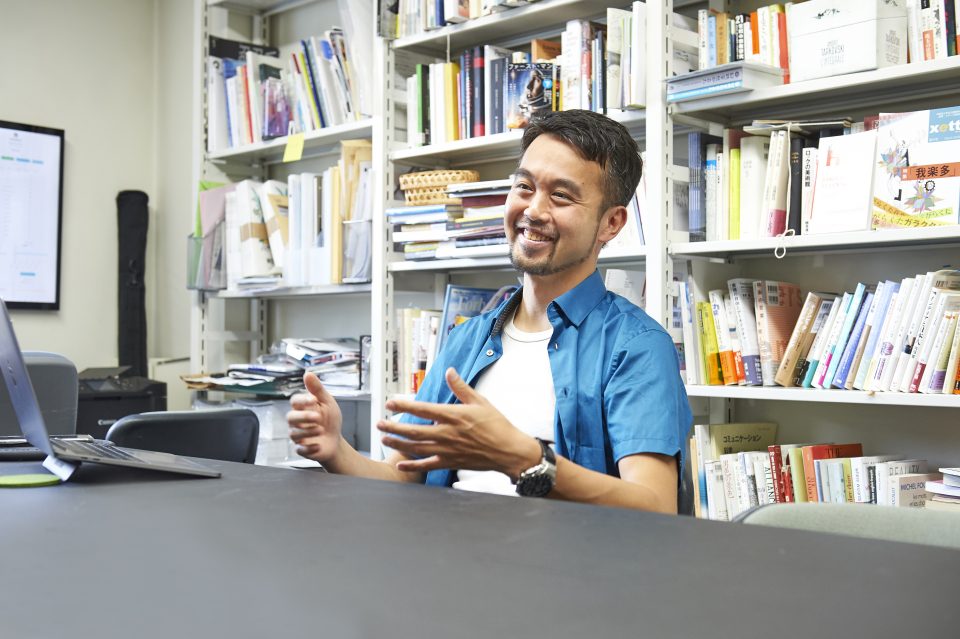

Dominique Chen is an associate professor at the Faculty of Letters, Arts and Sciences at Waseda University, an informatics researcher, and an entrepreneur. The question we were interested in was why Dominique — who is active in the informatics field researching how to link the world of computers, which handle objective information, with the world of subjective information, such as human psychology and the workings of the mind — became interested in fermentation and nukazuke [pickles made in a bed of fermented rice bran bed called a nukadoko]? We spoke with him on many other topics, such as his concept of the Nukadoko Mind and the NukaBot, a nukadoko robot that enables communications with a nukadoko.
Dominique first got interested in nukazuke some 10 years ago. It all started, he said, when he received a nukadoko as a present.
“I had launched a new company, and on the day the company was officially founded, my co-founder handed me a Tupperware container with about 100 grams of nukadoko, saying, ‘I’ll leave this in your hands.’ It was 50-year-old nukadoko that had been passed down in his family. I was delighted, but at the same time I felt it was a huge message, and I remember my body tensing up.”
It was Dominique’s first experience with nukazuke, but he took the container home with care, kicking off his nukazuke adventure.
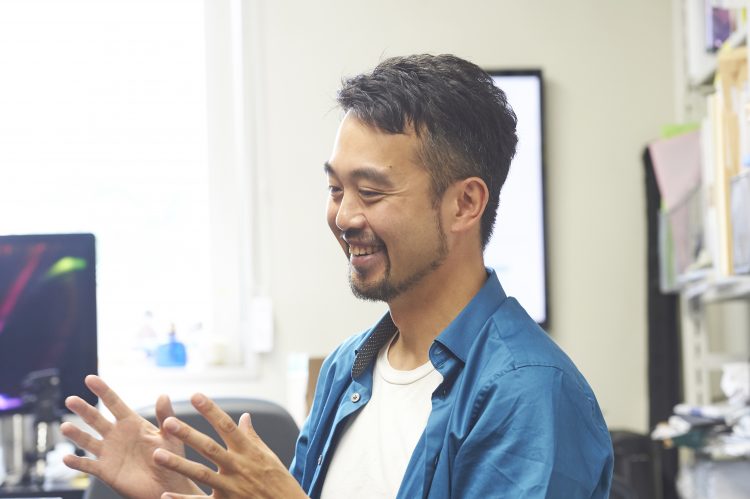
“I love starting new things, and I received the nukadoko just as the company launched. So, I was stoked as I started researching and getting to work. The first thing I got was a huge enameled container weighing about five kilograms. The volume of the new nuka completely covered the original 100 grams of nuka lying dormant at the bottom of the container. I was a bit worried initially about the smell of the new nuka and whether the new nuka might overrun the original nuka. But about a week after I started pickling, the color, aroma, and texture changed, and I could sense that the microorganisms in the original 100 grams of nuka were propagating well and flourishing.”
Dominique has been enthralled day after day with the deliciousness of the nukazuke pickled in the nukadoko. Captivated by the rich taste of the nukazuke, which was completely unlike any existing pickles he had tasted, he made it a habit after coming home from work every day to take out some nukazuke and pickle some new vegetables in the nukadoko.
“I was living on my own at the time, so I was surviving on just rice, miso soup, and nukazuke. It was simple diet, but I was more than pleased. It was so delicious that I wanted my friends to try it too. I was delighted when after giving them some as gifts, they would rave about the taste. I pickle the typical vegetables like cucumbers and carrots, but my favorite is eggplant. Probably because it’s easy to see how the eggplant transforms before and after pickling. I love the crispy texture and nourishing flavor that nukazuke gives it.”
Dominique was building IT systems at the newly launched company and then coming home and stirring the nukadoko. During this time, he was suddenly struck by the idea that the Internet and the nukadoko are similar in nature.
“Talking” is a splendid act of expression. In essence, it involves the body taking in information from the outside world, which wiggles around in the conscious and unconscious mind, and then the information is, on occasion, transmitted to the outside world again as an expression using your mouth or hands. Dominique believes that this act of expression can be likened to fermentation, an act whereby microorganisms metabolize nutrients in response to vegetables entering the nukadoko.
“For example, the act of tweeting on Twitter is like the bubbling fermentation of each person in the nukadoko of Twitter. Sometimes tweets react with each other and push the fermentation process along, and other times, they turn to rot. I had this illusion that the Internet is like a nukadoko — like a world where fermentation and decay are at war with each other.” [laughs]

The enameled container Dominique purchased when he first tried his hand at nukadoko. Because of the container’s size, he was a bit worried whether the bacteria in the nukadoko he received would actually work.
Dominique remained fascinated with the wonder, amusement, and complexity of his nukadoko. So much so, that he arranged occasions to speak about his hobby, such as talking about the cultural and social implications of fermented food and nukadoko in his publications and discussing fermentation and how nukadoko overlaps with his own field of informatics at talk events and on radio programs.
Then one day, a novel idea occurred to him: What if a nukadoko could move around on its own and relocate to a place where fermentation was easier? He discussed this idea with Ogura Hiraku, a fermentation designer, which led to the concept of a nukadoko robot, the NukaBot.
“The truth is I’d had some sad experiences. I left the first-generation nukadoko I got outside for half a day on a hot summer day and it went bad. On multiple occasions my nukadoko decayed, but I continued to create new nukadoko. The problem was I could never attain the rich flavor of the original nukadoko. So, it’s probably those thoughts and experiences that subconsciously gave rise to the concept of a nukadoko that could move on its own to a more comfortable place. If it were possible, that original nukadoko would not have gone off that day. What’s more, a mobile nukadoko might be able to produce the same, or perhaps even better, delicious nukazuke as the 50-year-old nukadoko.”

Dominique and Ogura began to conceptualize how to build the NukaBot. The first questions they sought answers to were: In what state do the diverse microorganisms live in a nukadoko that produces delicious nukazuke, and what are the requirements to achieve that state? Aided by Ogura and his expert knowledge on fermentation and by pouring over past research papers, Dominique was able to formulate a hypothesis about the workings of lactic acid and other bacteria and yeasts, the pH levels, and other factors in the process by which nukadoko ferment. He also enlisted Young ah Seong , a scent and odor researcher, to help investigate the ripening scent that a nukadoko gives off during the fermentation process and propel the creation of the NukaBot forward.
To test their nukadoko growth hypothesis, the group attached sensors to measure key indicators like the pH level, as well as sensors to measure the gases that generate odors, to the nukadoko, taking and graphing 15 measurements every minute. These measurements allowed them to visualize how the microorganisms in a nukadoko live.
The next challenge was how to determine from these data points whether the nukadoko was fermenting or decaying.
“Both Ogura and I have years of experience with nukazuke, so we can tell if a nukadoko is fermenting or decaying. What’s difficult is judging whether it produces delicious nukazuke. Judging tastes is obviously subjective. Even my 7-year-old daughter and I have very different opinions about taste. But after some twists and turns, we decided to rate deliciousness roughly on a five-level scale and record what was pickled, when it was stirred, and so on.”
NukaBots were set up in Ogura’s and Seong ’s homes for three months to test the hypothesis against actual measurements. By collecting data both when the NukaBots were fermenting well and when they decayed, they found that overall the hypothesis was not far off and that the data could be used to determine whether the nukadoko had gone bad or was starting to go bad. They also discovered that as the pH level dropped, the deliciousness of the produced nukazuke improved.
“The nuka contains both weakly anaerobic lactic acid bacteria that do not require much oxygen and aerobic metabolizing bacteria that require oxygen for metabolism. We used to call aerobic metabolizing bacteria ‘bad’ bacteria because they are a bit rowdy. [laughs] When the nuka is agitated, the surface nuka exposed to the air sinks to the bottom. It is generally known that stirring up the nuka suppresses the growth of aerobic metabolizing bacteria, or ‘bad’ bacteria, and activates lactic acid bacteria. In our experiment, we were able to see in the data that stirring up the nuka every day, which is vital to activate lactic acid bacteria, lowers the pH level of the nukadoko. This effect showed up in the taste data too.”
Through their testing, the researchers were able to form the hypothesis that the nukadoko goes through three major phases of growth.
“The very first week is the salt-pickling phase, during which vegetables neither spoil nor ferment. The following two weeks or so are the pickle phase, where the vegetables ferment slightly, similar to pickles, but are not mature enough to be called nukazuke. Then, after about 30 days after starting the nukazuke, the pH level drops and both lactic acid bacteria and other fermenting bacteria, such as aerobic metabolizing bacteria, become active, and the nukadoko phase begins, during which various parameters fluctuate but an overall balance is maintained.”
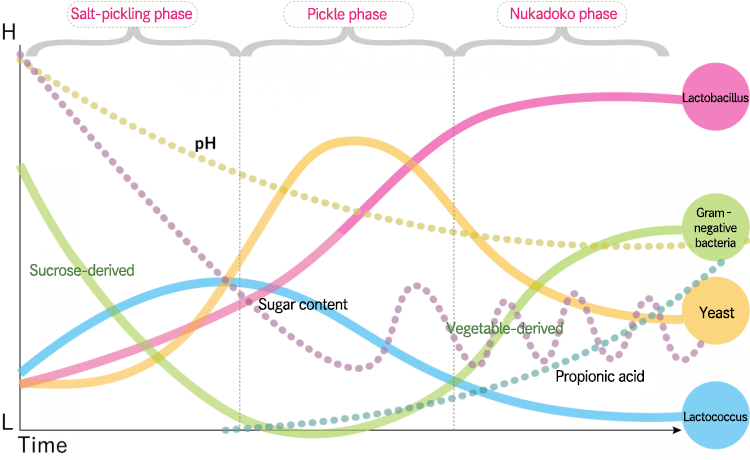
While there are still many unknowns, Dominique and his team have gained a great deal of understanding about the actions of the microorganisms in a nukadoko and about fermentation and decay.
The NukaBot continues to evolve quickly as a nukadoko that can communicate, as Dominique says. “Our initial concept was to have a nukadoko that could move on its own. But as we progressed, we decided to understand thoroughly the workings of the nukadoko and put priority on being able to communicate with it.” For example, by connecting the NukaBot to a voice-recognition speaker, it can speak several sentences, such as “Please stir me”, based on the condition of the nukadoko determined from its data. Product designer Moriya Kiichi also redesigned the NukaBot. The initial design looked like a smart speaker. After the redesign, it became a warm, hand-crafted wooden tub, fitted with a Nikodama eye developed by the artist Kuwakubo Ryota and Perfektron . In its new form, you almost can’t help yourself calling out to the NukaBot.

“The NukaBot has turned into a nukadoko that radiates a life force people are attracted to. For example, you speak to it and it responds and its eye moves. There is a multitude of microorganisms living in the nuka, and its appearance now is more like a living thing. When I saw my cat jump with surprise when the NukaBot said ‘It’s almost time to pickle’, I knew it was a success. [laughs] The NukaBot lets me know right away what the nukadoko’s condition is, so I’m much less likely to be guilty of child neglect. [laughs] I’m also more willing now to try out various things, like seeing what happens if I add red peppers from Central and South America or whether pickled rhubarb will taste any good. If you are only looking for traditional nukazuke, then a regular nukadoko will be fine. But if the nukadoko sends you messages, then I hope people will try pushing the envelope and expand the possibilities of tastes from a nukadoko.
Occasionally, people will ask me if the NukaBot knows when best to stir the nuka, couldn’t you make it stir automatically? But I go back to our starting point when we conceived of the NukaBot; that is, to be able to communicate with the nukadoko and actively engage with it. So, I don’t see the point in automating the stirring process.”

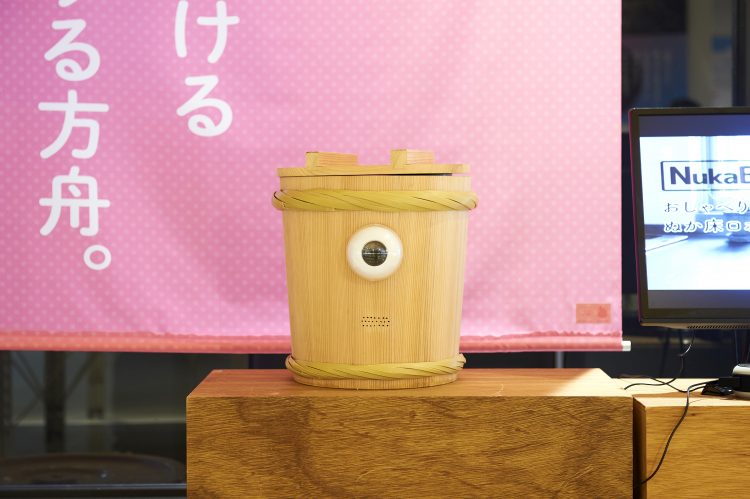
The version of the NukaBot that speaks through a voice-recognition speaker is on exhibit at the Triennale Milano: Broken Nature exhibition until September 2019. The latest wooden version is on show at the Fermentation Tourism Nippon event held at Tokyo’s Shibuya Hikarie until July 22.

“As the NukaBot has shown us, the nukadoko acquires its distinctive flavor by moving between the states of fermentation and decay. Even if the surface of the nukadoko starts to rot because of the so-called ‘bad’ aerobic metabolizing bacteria, pushing them back into the bed not only restores the health of the nukadoko, it can also deepen the flavor, contrary to what you might think. I’m fascinated by the way the nukadoko moves back and forth across the boundary of fermentation and decay.”
Dominique says it’s interesting to compare human society to the phases of the nukadoko.
“For example, when I attended a conference in the U.S. for bacteriology and hygiene researchers and entrepreneurs, what they talked about was that kids today are too clean and that this makes them more susceptible to diseases. Of course, there are a complex set of factors at play here, but what everyone agreed on is that our modern society tries too hard to be clean. What they were claiming, in effect, was striving to eliminate artificially all bacteria considered harmful has an opposite and adverse effect on the human body because the balance among bacteria is thrown off.”
Dominique says a similar theory exists regarding human psychology.
“Until now, it has been believed that increasing positive emotions as much as possible and eliminating negative emotions is good for one’s wellbeing. In recent years, however, it has been hypothesized that wellbeing is improved when both positive and negative emotions are felt on a regular basis. Clinical trials have shown that if we try to feel only elation and positive emotions, we will lose our mental balance somewhere along the line. This theory has been greeted with surprise in the U.S. and other countries. When I heard about it, I felt the theory was very nukadoko-like. For example, a state like the nukadoko phase cannot be achieved with lactic acid bacteria alone; it requires a certain amount of aerobic metabolizing bacteria as well, which we deem as ‘bad’ bacteria. Balancing good and bad, which fluctuate like a wave, is what is natural and is what produces abundance.”
If this theory is correct, Dominique believes that the current state of modern medicine is in the pickle phase and may be set up for a major evolution in the future. He adds that it is crucial to be proactively involved in the relationship.
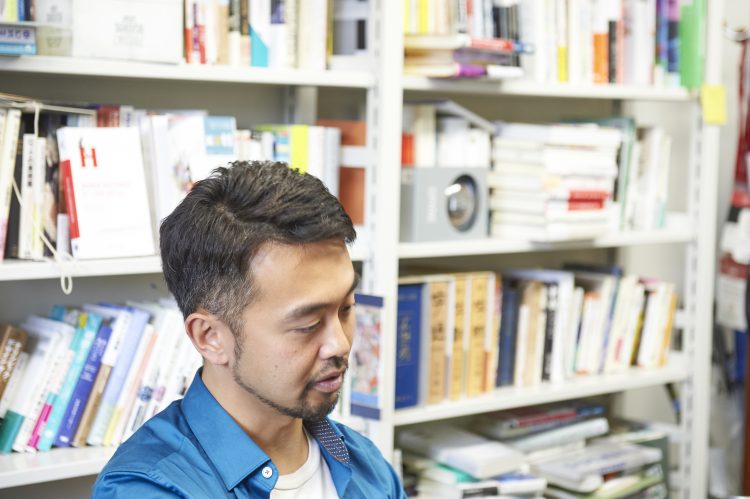
“I believe it’s important to be proactively involved in one’s relationships — whether with nukadoko, with your own mind and spirit, or with family and friends — much like stirring a nukadoko, rather than attempting to control the relationship. Objectively speaking, it may seem that you are controlling what is going on inside the nukadoko, but as a subjective experience, it feels as if you are at the mercy of the bacteria — as if you were feeding a pet. You sense messages emanating from the bacteria by scent and texture, as if the bacteria were raising their hands: ‘Wait a minute’. I think this is how living things relate with each other. Precisely because they are living things, they sync up with the rhythm of your life and feel like a part of your life. How active you are involved with them is reflected in whether they are vibrant and lively or dull and lacking energy. You could say that active involvement, which is different from control, plays a part in the deliciousness of food. This concept can be translated to human relationships. When parents try to control their children, or supervisors try to control their subordinates, it will not go well. I believe you can achieve a good balance in relationships by adopting the Nukadoko Mind.”
We ended our conversation by asking Dominique about the future of his nukadoko research. He gave the following answer.
“With nukadoko research, no matter how hard we try, we can only get one sensory evaluation a day, so I’ve been forced to make it my life’s work. [laughs] Another challenge is that people’s taste preferences vary substantially. However, as we continue to collect lots of data, we may be able to divide the process into some ten phases, not just the three current phases of salt-pickling, pickle, and nukadoko. With more data, we will find more ways to enjoy nukadoko and the nukadoko itself will evolve. In the years to come, a nukadoko may evolve to the point where it can move on its own and meet you at your doorstep, saying: ‘I’ve been waiting for you. Hurry up and start stirring.’ I hope to advance my research while enjoying the co-evolution of people and nukadoko.”
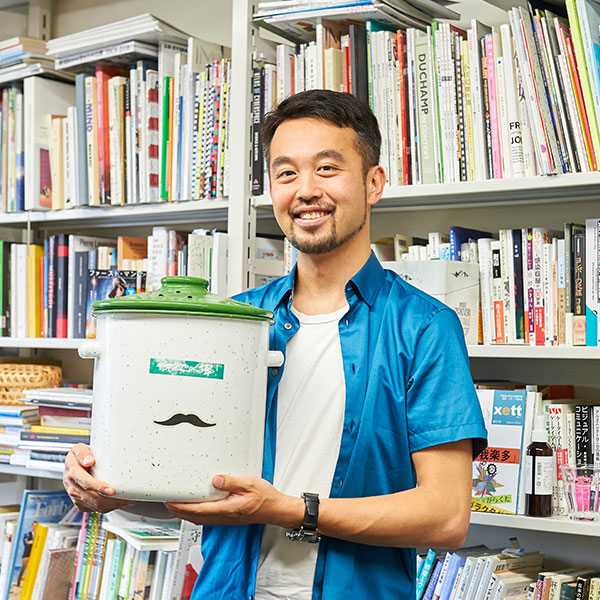
A French national born in Tokyo in 1981, Dominique is an associate professor at the School of Culture, Media and Society, Waseda University, co-founder of Dividual Inc., and board member of the NPO Commonsphere / Creative Commons Japan. A graduate of the University of California in Los Angeles, he earned a PhD in emerging design and informatics from the Graduate School of Interdisciplinary Information Studies, University of Tokyo.
Selected publications include Cyborgs' Religio: Create Minds in the Big Data Society (NTT Publishing), Bringing the Internet to Life: Prochronism in Thought and Practice (Seidosha), Making and Moving ALife: An Introduction to Artificial Life Model Theory through Implementation (O’Reilly Japan, co-author), Riddle Floor: The Editing Technique Where Thoughts Ferment (Shobunsha, co-author), and The Information Umwelt: A Guidebook for Playing between the Body and AI (NTT Publishing, co-author).
He also writes a column called “Ferment Media Research” where he outlines his studies into fermentation, which can be found at https://wired.jp/series/ferment-media-research/.